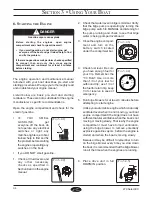
5.2
S
ECTION
5 • F
UEL
S
YSTEM
270 Select EX
2. F
UELING
P
RECAUTIONS
Certain precautions must be carefully and
completely observed every time a boat is fueled,
even with diesel fuel. Diesel fuel is nonexplosive
but it will burn.
A. S
TATIC
E
LECTRICITY
AND
THE
F
UEL
S
YSTEM
There is a danger that static electricity can ignite
gasoline vapors that have not been ventilated
outside an enclosed area. Use extreme caution
when fueling your boat from a source outside the
regular venues, (e.g. marinas, fuel service stations.)
Your boat has safety features that can be
circumvented by not adhering to standard fueling
practices. Your boat’s bonding system protects it
from creating and discharging static electricity.
Your boat must be in contact with the water or a
land based grounding system. Here are some
helpful suggestions to keep you safe from static
electricity while refueling your boat.
•
NEVER fuel your boat in unsafe conditions such
as: suspended on a sling or in a situation that
increases the likelihood of static discharge.
•
NEVER use homemade containers to fill your
fuel tank.
•
Fuel carried onboard outside of a fixed fuel
system should be stored in an approved
container or in a portable tank such as provided
for outboard engines and be stowed safely
outside of the engine or living compartments.
•
Shutdown the engine, motors and fans prior to
taking on fuel. Any ignition sources should be
extinguished before filling the fuel tank.
•
Close all ports, windows, doors, and hatches.
Diesel engine exhaust and some of its constituents
are known to the state of California to cause cancer,
birth defects and other reproductive harm.
!
WARNING
CALIFORNIA PROPOSITION 65
•
Fueling should never be done at night except in
well-lighted areas.
•
Always keep the fuel nozzle in contact with the
fuel fill plate or the edge of the fuel tank opening
throughout the filling process.
•
Allow areas where gasoline vapors could collect
to be ventilated before starting the engine(s).
•
Wipe any spillage completely and dispose of
rags or waste on shore.
•
Secure the fill cap tightly.
•
Fuel tank should never be filled to capacity.
Allow for fuel expansion.
•
Portable tanks should only be filled while on the
ground; never onboard the boat.
B. G
ENERAL
:
•
Check fill plate label to ensure fuel is placed
only in fuel tank. Fuel fill plate is located port
midship on the deck (Fig. 5.3.1).
•
Avoid spills.
•
Know your fuel capacity and consumption.
Record the amount of fuel used since your last
fill up, and compute the engine’s hourly fuel
usage. As a fuel gauge backup check, deduct
the average hourly fuel usage from fuel tank
capacity.
•
Observe the “Rule of Thirds”: one-third fuel for
trip out, one-third for return and one-third for
reserve.
•
Allow an additional 15 percent fuel reserve when
operating in rough seas.
Summary of Contents for 270 Select EX
Page 1: ...Owner s Manual Part Number MRP 1803645 Sea Ray Owner s Manual 270 Select EX...
Page 2: ......
Page 4: ...270 Select EX ii THIS PAGE LEFT INTENTIONALLY BLANK...
Page 46: ...2 16 SECTION 2 GENERAL BOAT ARRANGEMENT 270 Select EX THIS PAGE LEFT INTENTIONALLY BLANK...
Page 66: ...5 4 SECTION 5 FUEL SYSTEM 270 Select EX THIS PAGE LEFT INTENTIONALLY BLANK...
Page 102: ...7 12 SECTION 7 OPTIONS ACCESSORIES 270 Select EX THIS PAGE LEFT INTENTIONALLY BLANK...
Page 106: ...270 Select EX Index 4 INDEX THIS PAGE LEFT INTENTIONALLY BLANK...
















































